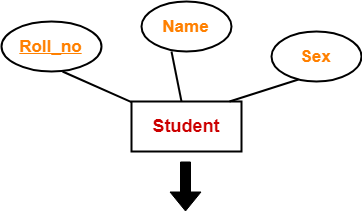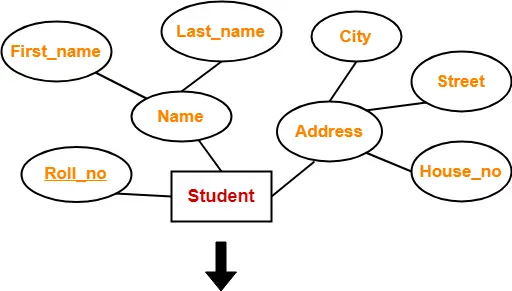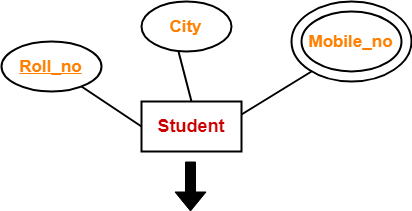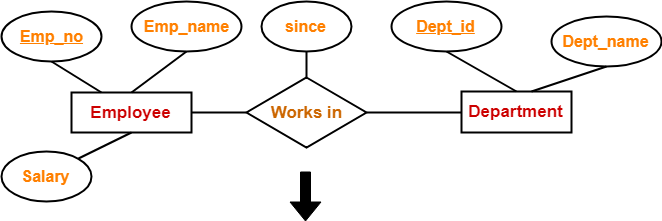Draw Er Diagram and Convert It Into a Relational Schema
Converting ER Diagrams to Tables-
Afterwards designing an ER Diagram,
- ER diagram is converted into the tables in relational model.
- This is considering relational models can exist easily implemented past RDBMS like MySQL , Oracle etc.
Following rules are used for converting an ER diagram into the tables-
Dominion-01: For Strong Entity Set With Only Simple Attributes-
A strong entity set with only simple attributes will require simply ane table in relational model.
- Attributes of the table will be the attributes of the entity set.
- The primary fundamental of the table volition be the key attribute of the entity set.
Instance-

Schema : Student ( Roll_no , Proper name , Sex )
Too Read- Entity Sets in DBMS
Rule-02: For Strong Entity Set With Composite Attributes-
- A strong entity set with any number of blended attributes volition require just one tabular array in relational model.
- While conversion, uncomplicated attributes of the blended attributes are taken into account and not the composite attribute itself.
Case-

| Roll_no | First_name | Last_name | House_no | Street | Metropolis |
Schema : Educatee ( Roll_no , First_name , Last_name , House_no , Street , Urban center )
Besides Read- Types of Attributes in DBMS
Rule-03: For Strong Entity Set With Multi Valued Attributes-
A strong entity fix with whatsoever number of multi valued attributes will require two tables in relational model.
- One table will contain all the simple attributes with the main central.
- Other table will comprise the primary key and all the multi valued attributes.
Example-

Rule-04: Translating Human relationship Set into a Tabular array-
A human relationship gear up will require 1 tabular array in the relational model.
Attributes of the tabular array are-
- Chief key attributes of the participating entity sets
- Its own descriptive attributes if whatsoever.
Prepare of non-descriptive attributes will exist the primary central.
Example-

Schema : Works in ( Emp_no , Dept_id , since )
NOTE-
If we consider the overall ER diagram, three tables will be required in relational model-
- I table for the entity fix "Employee"
- One tabular array for the entity set "Section"
- 1 table for the relationship set "Works in"
Dominion-05: For Binary Relationships With Cardinality Ratios-
The following 4 cases are possible-
Case-01: Binary human relationship with cardinality ratio m:n
Case-02: Binary relationship with cardinality ratio 1:north
Case-03: Binary human relationship with cardinality ratio m:1
Case-04: Binary human relationship with cardinality ratio 1:1
Also read- Cardinality Ratios in DBMS
Case-01: For Binary Relationship With Cardinality Ratio thousand:n

Here, three tables will be required-
- A ( a1 , a2 )
- R ( a1 , b1 )
- B ( b1 , b2 )
Case-02: For Binary Relationship With Cardinality Ratio 1:n

Here, two tables volition be required-
- A ( a1 , a2 )
- BR ( a1 , b1 , b2 )
NOTE- Hither, combined table will exist fatigued for the entity set B and relationship set R.
Example-03: For Binary Relationship With Cardinality Ratio m:1

Hither, two tables will be required-
- AR ( a1 , a2 , b1 )
- B ( b1 , b2 )
NOTE- Here, combined tabular array will be drawn for the entity fix A and human relationship set R.
Case-04: For Binary Human relationship With Cardinality Ratio 1:1

Here, two tables volition be required. Either combine 'R' with 'A' or 'B'
Mode-01:
- AR ( a1 , a2 , b1 )
- B ( b1 , b2 )
Mode-02:
- A ( a1 , a2 )
- BR ( a1 , b1 , b2 )
Pollex Rules to Remember
While determining the minimum number of tables required for binary relationships with given cardinality ratios, following thumb rules must be kept in mind-
- For binary human relationship with cardinality ration m : due north , separate and individual tables will be fatigued for each entity set and human relationship.
- For binary relationship with cardinality ratio either m : 1 or 1 : due north , e'er remember "many side will consume the relationship" i.e. a combined table will be fatigued for many side entity set and relationship set.
- For binary relationship with cardinality ratio 1 : one , 2 tables will exist required. Yous tin can combine the relationship set with any one of the entity sets.
Rule-06: For Binary Relationship With Both Cardinality Constraints and Participation Constraints-
- Cardinality constraints volition be implemented as discussed in Dominion-05.
- Because of the total participation constraint, foreign central acquires Non NULL constraint i.e. at present foreign central can not exist nix.
Case-01: For Binary Relationship With Cardinality Constraint and Full Participation Constraint From One Side-

Because cardinality ratio = 1 : n , so we will combine the entity set B and relationship set R.
Then, 2 tables will be required-
- A ( a1 , a2 )
- BR ( a1 , b1 , b2 )
Because of total participation, foreign key a1 has acquired NOT Zip constraint, so it can't exist null now.
Case-02: For Binary Relationship With Cardinality Constraint and Full Participation Constraint From Both Sides-
If there is a central constraint from both the sides of an entity set with total participation, then that binary relationship is represented using only single tabular array.

Here, But one table is required.
- ARB ( a1 , a2 , b1 , b2 )
Dominion-07: For Binary Relationship With Weak Entity Set-
Weak entity set always appears in association with identifying relationship with total participation constraint.

Here, two tables will exist required-
- A ( a1 , a2 )
- BR ( a1 , b1 , b2 )
Side by side Commodity- Practice Bug On Converting ER Diagrams to Tables
Get more notes and other study textile of Database Direction Organisation (DBMS).
Picket video lectures by visiting our YouTube channel LearnVidFun.
Source: https://www.gatevidyalay.com/tag/convert-er-diagram-to-relational-schema/
0 Response to "Draw Er Diagram and Convert It Into a Relational Schema"
Post a Comment